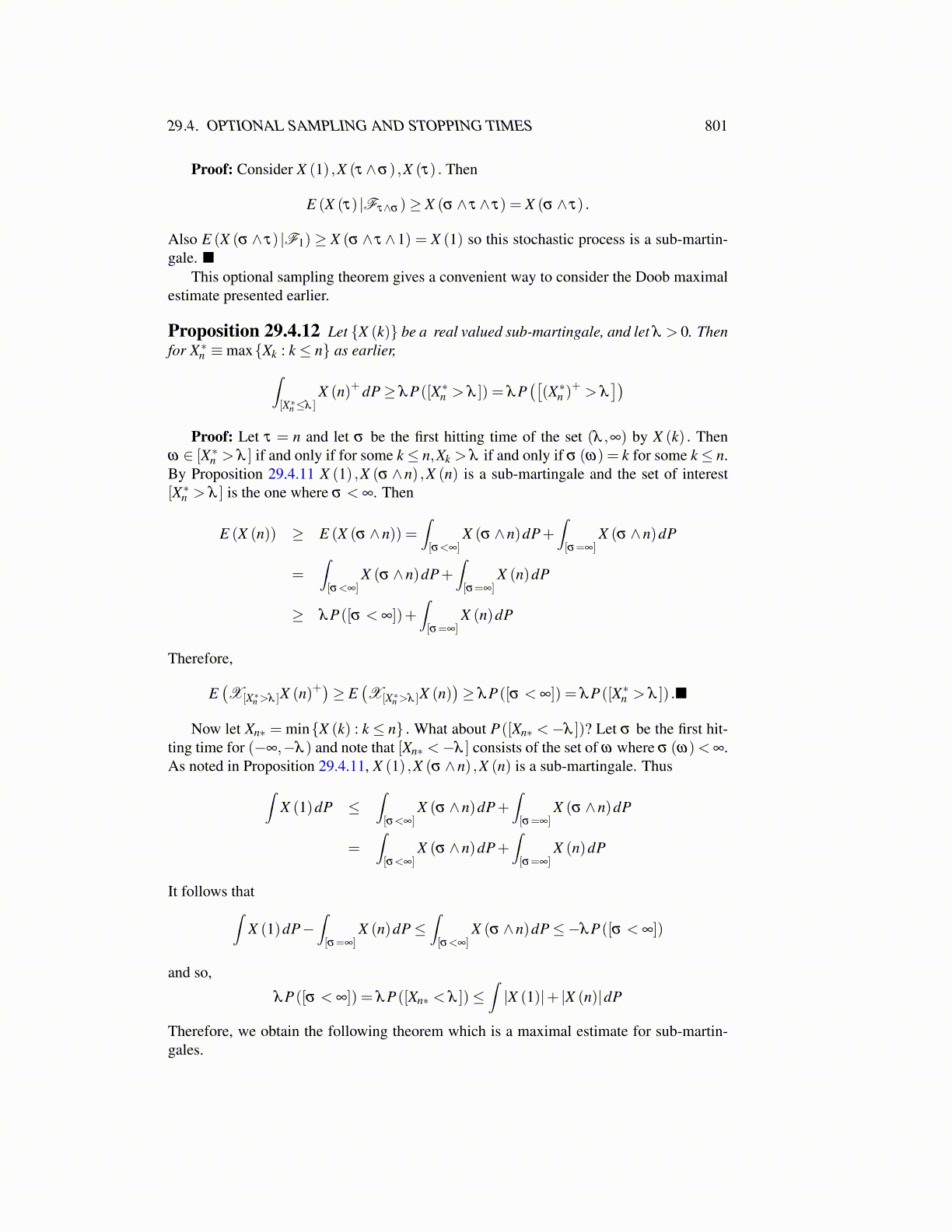
29.4. OPTIONAL SAMPLING AND STOPPING TIMES 801
Proof: Consider X (1) ,X (τ ∧σ) ,X (τ) . Then
E (X (τ) |Fτ∧σ )≥ X (σ ∧ τ ∧ τ) = X (σ ∧ τ) .
Also E (X (σ ∧ τ) |F1) ≥ X (σ ∧ τ ∧1) = X (1) so this stochastic process is a sub-martin-gale. ■
This optional sampling theorem gives a convenient way to consider the Doob maximalestimate presented earlier.
Proposition 29.4.12 Let {X (k)} be a real valued sub-martingale, and let λ > 0. Thenfor X∗n ≡max{Xk : k ≤ n} as earlier,∫
[X∗n≤λ ]X (n)+ dP≥ λP([X∗n > λ ]) = λP
([(X∗n )
+ > λ])
Proof: Let τ = n and let σ be the first hitting time of the set (λ ,∞) by X (k) . Thenω ∈ [X∗n > λ ] if and only if for some k≤ n,Xk > λ if and only if σ (ω) = k for some k≤ n.By Proposition 29.4.11 X (1) ,X (σ ∧n) ,X (n) is a sub-martingale and the set of interest[X∗n > λ ] is the one where σ < ∞. Then
E (X (n)) ≥ E (X (σ ∧n)) =∫[σ<∞]
X (σ ∧n)dP+∫[σ=∞]
X (σ ∧n)dP
=∫[σ<∞]
X (σ ∧n)dP+∫[σ=∞]
X (n)dP
≥ λP([σ < ∞])+∫[σ=∞]
X (n)dP
Therefore,
E(X[X∗n >λ ]X (n)+
)≥ E
(X[X∗n >λ ]X (n)
)≥ λP([σ < ∞]) = λP([X∗n > λ ]) .■
Now let Xn∗ = min{X (k) : k ≤ n} . What about P([Xn∗ <−λ ])? Let σ be the first hit-ting time for (−∞,−λ ) and note that [Xn∗ <−λ ] consists of the set of ω where σ (ω)< ∞.As noted in Proposition 29.4.11, X (1) ,X (σ ∧n) ,X (n) is a sub-martingale. Thus∫
X (1)dP ≤∫[σ<∞]
X (σ ∧n)dP+∫[σ=∞]
X (σ ∧n)dP
=∫[σ<∞]
X (σ ∧n)dP+∫[σ=∞]
X (n)dP
It follows that∫X (1)dP−
∫[σ=∞]
X (n)dP≤∫[σ<∞]
X (σ ∧n)dP≤−λP([σ < ∞])
and so,
λP([σ < ∞]) = λP([Xn∗ < λ ])≤∫|X (1)|+ |X (n)|dP
Therefore, we obtain the following theorem which is a maximal estimate for sub-martin-gales.